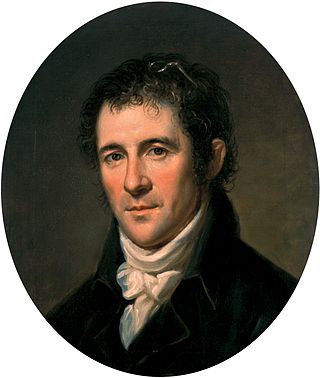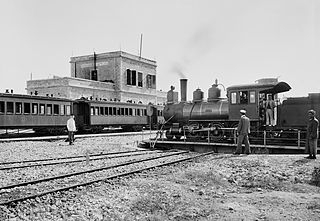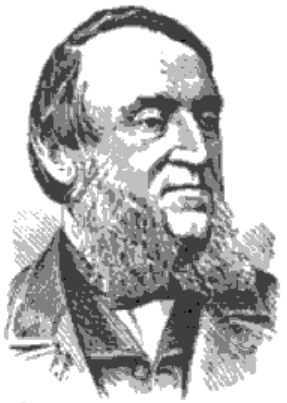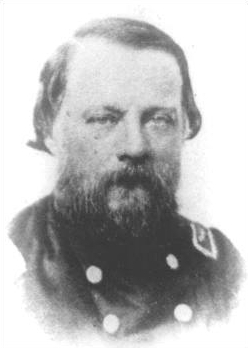
Benjamin Henry Boneval Latrobe was a British-American neoclassical architect who immigrated to the United States. He was one of the first formally trained, professional architects in the new United States, drawing on influences from his travels in Italy, as well as British and French Neoclassical architects such as Claude Nicolas Ledoux. In his thirties, he immigrated to the new United States and designed the United States Capitol, on "Capitol Hill" in Washington, D.C., as well as the Old Baltimore Cathedral or The Baltimore Basilica,. It is the first Cathedral constructed in the United States for any Christian denomination. Latrobe also designed the largest structure in America at the time, the "Merchants' Exchange" in Baltimore. With extensive balconied atriums through the wings and a large central rotunda under a low dome which dominated the city, it was completed in 1820 after five years of work and endured into the early twentieth century.
This section of the timeline of United States history concerns events from 1820 to 1859.

The Garden District is a neighborhood of the city of New Orleans, Louisiana, United States. A subdistrict of the Central City/Garden District Area, its boundaries as defined by the New Orleans City Planning Commission are: St. Charles Avenue to the north, 1st Street to the east, Magazine Street to the south, and Toledano Street to the west. The National Historic Landmark district extends a little farther.

Pelican Stadium, originally known as Heinemann Park (1915–1937), was a sports stadium in New Orleans, Louisiana from 1915 to 1957.

James Gallier was a prominent nineteenth-century Irish-born American architect, most famed for his buildings in New Orleans. Gallier Hall, which he designed and once served as New Orleans City Hall, is named after him.

The buildings and architecture of New Orleans reflect its history and multicultural heritage, from Creole cottages to historic mansions on St. Charles Avenue, from the balconies of the French Quarter to an Egyptian Revival U.S. Customs building and a rare example of a Moorish revival church.
James Harrison Dakin was an American architect who designed Neo-Gothic buildings and was the architect for the Old Louisiana State Capitol, Old Bank of Louisville, and other public buildings.

The Jaffa–Jerusalem railway is a railway that connected Jaffa and Jerusalem. The line was built in the Mutasarrifate of Jerusalem by the French company Société du Chemin de Fer Ottoman de Jaffa à Jérusalem et Prolongements and inaugurated in 1892. The project was headed by Joseph Navon, an Ottoman Jewish entrepreneur from Jerusalem, after previous attempts by the British-Jewish philanthropist Sir Moses Montefiore failed. While the first rail track in the Middle East was laid elsewhere, the line is considered to be the first Middle Eastern railway.
John Green and Benjamin Green were a father and son who worked in partnership as architects in North East England during the early nineteenth century. John, the father was a civil engineer as well as an architect. Although they did carry out some commissions separately, they were given joint credit for many of their projects, and it is difficult to attribute much of their work to a single individual. In general, John Green worked on civil engineering projects, such as road and rail bridges, whereas Benjamin worked on projects that were more purely architectural. Their work was predominantly church and railway architecture, with a sprinkling of public buildings that includes their masterpiece, Newcastle's Theatre Royal.

William Jarvis McAlpine was an American civil engineer and politician from New York. He was New York State Engineer and Surveyor from 1852 to 1853.

Albert Gallatin Blanchard was a general in the Confederate army during the American Civil War. He was among the small number of high-ranking Confederates to have been born in the North. He served on the Atlantic Coast early in the war, commanding a brigade in Virginia before being reassigned to administrative duty due to his age and health. Furthermore, he then led troops during the Carolinas Campaign in 1865.
James Savage was a British architect, based in London. His works included the Richmond Bridge in Dublin, and St Luke's Church, Chelsea, a pioneering work of the Gothic Revival. He was architect to the Honourable Society of the Middle Temple, and carried out restoration work at Lincoln Cathedral and St Mary-le-Bow. In 1836 he published a pamphlet in which he attacked the slavish imitation of historical styles.
Henry Michael Hyams was an American lawyer, planter and Democratic politician. He served as the 7th Lieutenant Governor of Louisiana from 1862 to 1864 under Governor Thomas Overton Moore during the American Civil War, when Louisiana joined the Confederate States of America. He was an advocate of slavery in the United States.

Romanesque Revival, Norman Revival or Neo-Norman styles of building in the United Kingdom were inspired by the Romanesque architecture of the 11th and 12th centuries AD.

The Carrollton Courthouse is a historic building in the Carrollton neighborhood of New Orleans, Louisiana, in the United States. Built in 1855, it originally served as a courthouse before being utilized by several public schools. In 2013, it became vacant after the previous tenant, a charter school, moved locations. In 2018, the Orleans Parish School Board sold the property to private developers. On February 15, 2023, the building was reopened as a luxury assisted living facility for senior citizens, after a three-year renovation to restore and repurpose the building.

Henry Howard (1818–1884) was an Irish-born American architect. Over the course of four decades, he designed over 280 buildings in Louisiana, including several plantation houses during the antebellum era. After the Civil War, he designed many town houses in New Orleans.

Thomas Fulljames FRIBA was an architect active in Gloucestershire, England, in the first half of the nineteenth century. As diocesan surveyor from 1832 until 1870, latterly in partnership with Frederick Sandham Waller, he designed, reconstructed or extended a number of churches in Gloucestershire.

John Hazlehurst Boneval Latrobe was an American lawyer and inventor. He invented the Latrobe Stove, also known as the "Baltimore Heater", a coal fired parlor heater made of cast iron and that fit into fireplaces as an insert. He patented his design in 1846. The squat stoves were very popular by the 1870s and were much smaller than Benjamin Franklin's Franklin stove.

The City Hotel in New Orleans, Louisiana, United States, located at the intersection of Camp and Common Streets, was one of the city's major antebellum hotels, but maybe not quite so storied as the older, larger, St. Louis and St. Charles Hotels. As explained by a city historian in 1922, the "social life of New Orleans revolved around its great hotels to a degree greater than was the case, probably, in other American city." As was the case with the St. Charles and the St. Louis, slave auctions were held at the City Hotel before the American Civil War.

Banks' Arcade was a multi-use commercial structure in New Orleans, Louisiana, United States. The building stood on the block bounded by Gravier Street, Tchoupitoulas Street, Natchez Street, and Magazine Street, in the district then known as Faubourg Sainte Marie, later known as the American sector and now called the Central Business District. The building's central axis, originally called Banks' Alley or the Arcade Passage, is now a walk street called Arcade Place within Picayune Place Historic District.
















